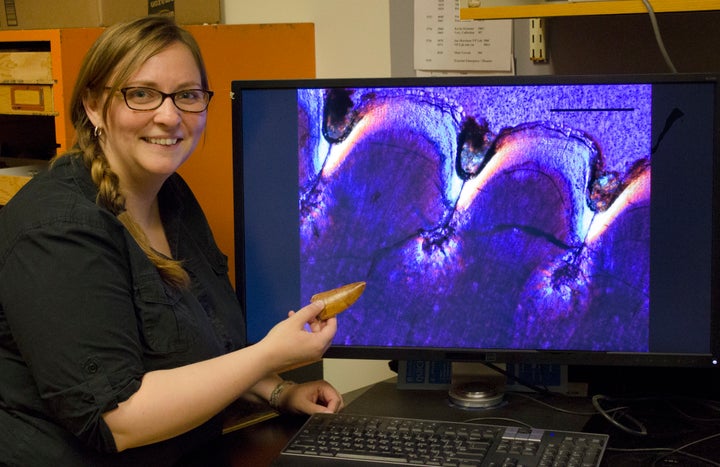There's no doubt Tyrannosaurus rex -- and other carnivorous dinosaurs -- had some terrifying chompers. But what made the teeth of these dinosaurs strong enough to effortlessly tear through the flesh and bone of their prey?
The serrated teeth of T. rex and other fearsome dinos had complex structures hidden inside to strengthen them, according to a study published Tuesday in Scientific Reports.
"The strange structure is actually a special arrangement of tooth tissues that increases the size of the serration, strengthening it and preventing it from wearing away quickly," Dr. Kirstin Brink, the study's lead author and a post-doctoral researcher at the University of Toronto-Mississauga in Canada, told The Huffington Post in an email. "The fact that theropod teeth are quite more complex than previously thought was a surprise to me."

For the study, Brink and her colleagues examined teeth from eight different species of theropod. Theropods -- the group of bipedal dinosaurs that includes T. rex, Allosaurus, Coelophysis and Gorgosaurus -- roamed the Earth about 200 million years ago and were dominant terrestrial meat-eaters, Reuters reports.
Scientists knew about the strange tissue structures inside theropod teeth before this study, but hadn't been able to determine if the structures were caused by stress on the teeth, Brink said.
Using a scanning electron microscope to take images of the teeth and a synchrotron microscope to examine their chemical composition, researchers analyzed both immature teeth that were not large enough to be used for feeding and mature teeth.
They found that both immature and mature theropod teeth had the unique tissue structures, which suggests the structures did not develop from stress over time but were a part of the teeth's biology from the animal's early development.
"This brought about a developmental explanation for the tooth formation; the serrations are even more spectacular and permanent," study co-author Dr. Robert Reisz, biology professor and vice dean of graduate studies at the University of Toronto-Mississauga, said in a written statement.

The researchers also concluded that the arrangement of the tissue structures were present in all theropods except the small Troodon.
While the structures are only common among carnivorous theropods, similar teeth can be found today in the mouths of Komodo dragons, which are the only living terrestrial animal with serrated teeth, Brink said.
How much do you really know about dinosaurs? Check out the "Talk Nerdy To Me" episode below for five dinosaur myths that you probably thought were true.
